WELCOME TO THE BIOINTENSIVE COMMUNITY.
GROW BIOINTENSIVE TM
A SUSTAINABLE SOLUTION FOR GROWING FOOD.
Principles of the GROW BIOINTENSIVETM
The Method
The high yields of the GROW BIOINTENSIVE® Method, its ability to build fertile soil up to 60 times faster than in nature, reduce water use by up to 88% in vegetables and 66% in grains, and significantly decrease the need for fertilizers, are all made possible by its eight core principles.
These principles are rooted in the ancestral agricultural practices of some of the world’s most successful civilizations. John Jeavons—creator of the Method—carefully studied and analyzed these traditions, identifying their foundations and grouping them into a comprehensive system.
When applying the Method, it is essential to fully embrace these principles, techniques, and solutions, which have been developed and refined over more than 52 years. It is not the Method that is being tested—it is our own capacity to achieve high yields sustainably, in small spaces, with limited resources, while simultaneously regenerating and enriching the soil.
For more detailed and in-depth information, please visit the Publications section.
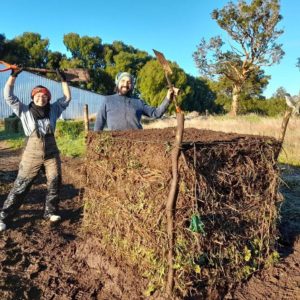
Soils around the world are increasingly depleted, polluted, compacted, eroded, and demineralized. In many cases, their microbiota has been almost entirely destroyed. This degradation is largely due to the use of heavy machinery and the overuse of chemical fertilizers. To reverse this trend, the GROW BIOINTENSIVE® Method promotes the use of Biointensive compost, which recycles crop residues, kitchen scraps, and other organic matter. This type of compost is easy to produce, virtually cost-free, and promotes the development of a rich and healthy soil microbiome. In addition, it restores the soil’s porous structure, allowing water and gases to circulate more freely. This encourages crops to develop strong, deep roots, resulting in healthy and abundant harvests.
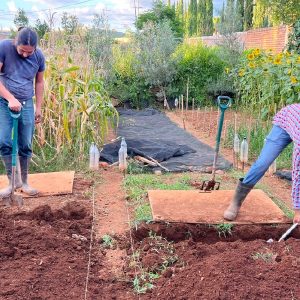
Through the technique of double digging, the soil is prepared to a depth of 60 centimeters using an ergonomic method that minimizes muscular effort by combining the intelligent use of body weight and gravity. This depth allows crops to fully develop their root systems. For example, the roots of corn, lettuce, and tomatoes can grow as deep as 120 centimeters, promoting healthier plants that are more resistant to pests. Deep, loose soil also facilitates weeding, reduces erosion, and retains moisture effectively—helping the soil stay hydrated without becoming waterlogged.
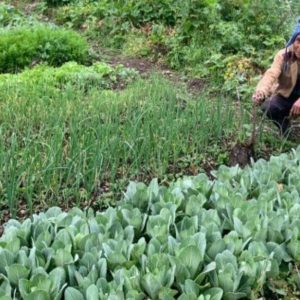
In the GROW BIOINTENSIVE® Method, seeds are not sown directly into the soil. Instead, they are first grown in seedbeds and then transplanted at the optimal stage of development. This approach offers many advantages, including significant water savings and the ability to protect seedlings from adverse weather conditions during their most vulnerable phase. Once ready, seedlings are transplanted into Biointensive beds measuring 1.25 meters wide, 8 meters long, and 60 centimeters deep (a total surface area of 10 m²), using a hexagonal spacing pattern (known as tresbolillo). In this pattern, each plant is equidistant from its neighbors, allowing the leaves to eventually touch as they grow. This creates a microclimate that helps retain moisture, protects vital soil microbiota, limits the spread of pests and diseases, delays weed growth, and contributes to higher yields. By avoiding the conventional furrow system, this technique optimizes water and space efficiency per unit of cultivated area.

As plants grow, they extract nutrients from the soil. To prevent soil depletion, it’s important not to grow the same crop repeatedly in the same bed. To guide crop rotation, plants are classified into three categories: • Donors: Leguminous plants that enrich the soil. • Light consumers: Tubers (excluding potatoes). • Heavy consumers: Most other crops. Practicing crop rotation not only supports consistent food quality, but also helps maintain a vibrant, nutrient-rich soil, ensuring long-term fertility and productivity. Companion planting takes advantage of the natural relationships between plants. Some grow better when planted near each other, forming beneficial alliances. Others may have negative interactions and should not be grown side by side. Certain plants repel pests, attract beneficial insects, or act as trap crops—plants that attract pests away from the main crop. For example, rue attracts aphids and coriander attracts whiteflies, protecting nearby vegetables. Some companion plants do both: for instance, borage helps control tomato worms while its blue flowers attract pollinators like bees. Additionally, many wild plants provide benefits to the soil: their deep roots loosen the subsoil and draw up trace elements and nutrients that would otherwise remain inaccessible.
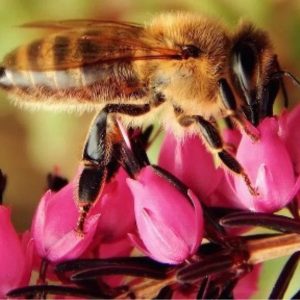
To be considered a truly sustainable Biointensive farmer, it is essential to produce your own key inputs: your compost, your seedlings, and—most importantly—your own seeds. The GROW BIOINTENSIVE® Method does not use hybrid or genetically modified (GMO) seeds. Instead, it relies exclusively on local, heirloom, or open-pollinated seeds—varieties selected and preserved over centuries by our ancestors for their resilience, adaptability to local conditions, and nutritional value. These seeds are particularly important in the face of climate change, as they offer a broad genetic base and are well-suited to diverse soils and weather patterns. Using open-pollinated seeds allows us to save money, preserve crop diversity, and support healthy pollinator populations. We strongly recommend establishing a seed house to store, exchange, and improve these seeds, strengthening their genetic resilience. This practice not only fosters independence from commercial seed markets, but also honors and preserves the agricultural heritage passed down by previous generations.

To ensure a steady supply of composting material and promote the recirculation of nutrients, the GROW BIOINTENSIVE® Method allocates approximately 60% of the garden area to crops that are highly efficient in producing biomass (carbon) and calories (seeds). These crops serve a dual purpose: they generate large amounts of carbonaceous material for compost production and simultaneously offer a significant source of calories for human consumption. Examples of these crops include cereals such as sorghum, corn, wheat, barley, rye, sugarcane, and oats; grain-producing plants like amaranth and quinoa; and others such as sunflower and broad beans. In contrast, modern agricultural systems often extract vast quantities of organic matter and nutrients from the soil and export them elsewhere in the form of harvested crops, leading to a net loss of fertility. This linear model is not sustainable. By prioritizing crops that yield high amounts of biomass per unit of area and reintegrating that biomass through composting, we move toward a closed-loop system—one that regenerates itself, retains nutrients in the soil, and embodies true agricultural sustainability.
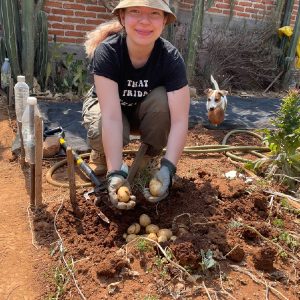
Small is beautiful—and in the GROW BIOINTENSIVE® Method, beauty lies in efficiency. This principle emphasizes maximizing food production in minimal space, which is key to true sustainability. In planning a garden, approximately 30% of the area is allocated to root crops, which are highly efficient in terms of both calories and weight per square meter. These include: • Tuber crops like potatoes, sweet potatoes, eddo (taro), yam, and cocoyam. • Root vegetables such as parsnip. • Bulbs like garlic and leek. These crops offer a high caloric return per unit of area, making them essential in small-scale, resource-conscious agriculture. Since vitamins are also a crucial part of a balanced diet, 10% of the area is dedicated to growing vegetables, which has proven sufficient to meet daily micronutrient needs. By combining high-yield root crops with vitamin-rich vegetables, the method ensures a nutritionally complete and spatially efficient food system.
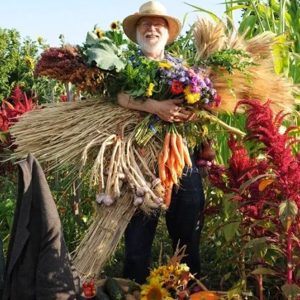
The GROW BIOINTENSIVE® Method is not just a collection of techniques—it is a complete agricultural system designed to produce food while regenerating soil fertility. Its eight principles must be applied together. If used in isolation or partially, the high yields achieved could exhaust the soil even faster than conventional farming methods. However, when fully implemented—using double-dug beds, compost fertilization, a wide diversity of crops started in seedbeds with open-pollinated seeds, and applying proper crop rotation and planning—the system enhances the soil’s natural abilities and long-term productivity.
When used correctly, this holistic method can:
•Produce 2 to 6 times more food than conventional systems •Build fertile soil up to 60 times faster than nature •Reduce by half (or more) the amount of land required to grow food With its integrated approach, the Method makes it virtually inevitable to cultivate a healthy, abundant, and sustainable garden—even in small spaces with limited resources
CONTACT US
- cultivebiointensivamente@gmail.com
ECOPOL , EL MEZQUITE (C) 2024 | TODOS LOS DERECHOS RESERVADOS


